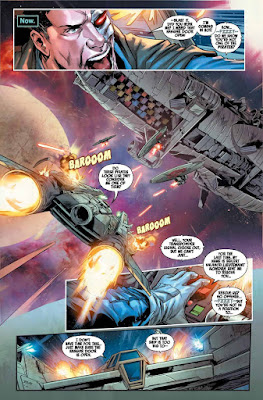I'm going to be honest at the start of this review, I've found that Star Wars: Bounty Hunters has been my least favourite of the current Star Wars comics. I think it might be because a lot of what happens in this book doesn't seem to really connect much to the rest of the Star Wars universe, and other than featuring some bounty hunters fans will recognise it's kind of off doing its own thing. This isn't necessarily bad, as it's adding more to the universe and expanding things, but I prefer it when the comics connect to the bigger story, even in tiny ways.
But I think that's why I really actually enjoyed this issue, and found it to be the best one of the series so far, as Valance heads off to rescue a lost Rebellion convoy. It might not have any of the bi heroes on it, and it doesn't seem to be making reference to bigger events, but by him coming in and helping to save a group of the good guys it just instantly feels more like the Star Wars that I love.
The issue begins, much like the last one did, with a flashback to Valance during his time at the Imperial Academy, where he was training to become a TIE pilot. After being shot down his squad leaves him behind, and he's forced to try and survive in the ruins of this hostile world. Not only does this flashback further flesh out Valance, as well as giving further insight into why the Empire sucks, but it shows that he knows about camaraderie, and going against orders when the rest of his squad, including a young Han Solo, return to rescue him.
This is something that I think very much informs his actions during the rest of the issue, when he's putting himself in danger to help a group of people who really don't trust him. The rebels don't really want him around, and the commander even throws him in the brig, refusing to let the bounty hunter get them out of a no win situation. It would have been easy for Valance to simply give up, or just leave all together, but instead he keeps throwing himself in danger to do the right thing and help these people.
It's something we've seen from the character before, taking the much harder path because his conscience won't let him take the easy way out, but I think this is one of the better examples of it. It's easy to get a morally grey character to do the right thing when it's to protect a kid, as we'd seen in earlier issues, but when it's like this, when he's pushed back against and told no over and over, where he could walk away guilt free, it means something more for him to stand up and be a hero.
We also get some development with the villains of this issue too, as we see that the rebels are under attack from the Ohnaka Gang, though Hondo himself isn't around. Whilst it's great to see the Ohnaka Gang are still around and doing some dodgy things during the time of the Empire I'm glad that Sacks made the smart choice of not including Hondo here, instead having the pirates under the command of another Weequay, Skaag. Hondo has always walked a fine line of hero and villain, and his time on Star Wars: Rebels has definitely made him walk closer to the hero side of things, so I'm pleased that he's not here attacking the Rebellion as it would have felt a bit wrong for him. The pirates are also joined by Dengar, another iconic bounty hunter; which I think now means that all of the bounty hunters from The Empire Strikes Back have had a chance to feature in the book.
The issue also has a short interlude on Ruusan, where it's revealed that T'Onga, the bounty hunter from the first story arc of the series, didn't perish as we'd all been led to believe. Not only is this a good decision to bring her back because it allows her character another chance to shine, but also brings back one of the few openly queer Star Wars characters. At the time of her 'death' it felt like another slap in the face to queer Star Wars fans, especially after that pathetic 'first lesbian kiss' thing that happened with The Rise of Skywalker being overly hyped yet a 'blink and you miss it' moment that meant nothing. I'm hoping that this is perhaps a small way of making it up to the queer fans of the franchise.
Overall I really enjoyed this issue of Star Wars: Bounty Hunters, and thought that this was one of the better showings for Valance as both a decent person and a competent fighter, especially when he got to take an X-Wing out for a spin. Fingers crossed that this quality will continue through the rest of the story arc.






























